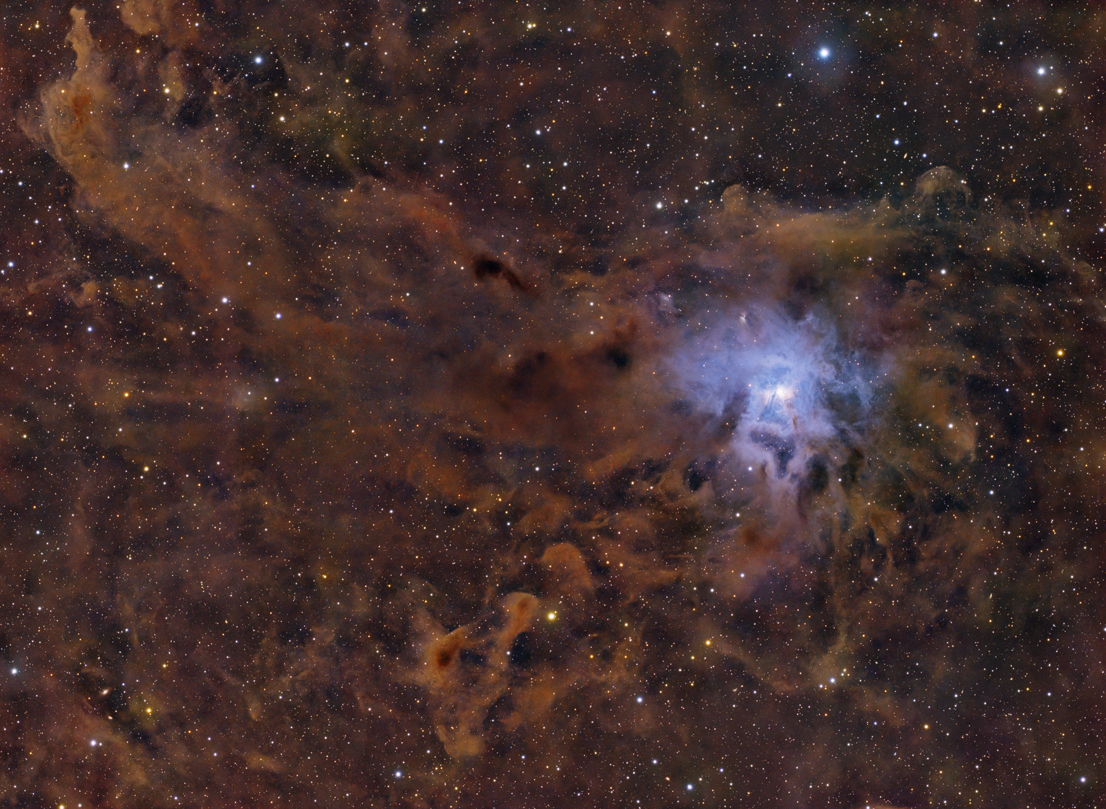Iris
Nebula (LBN 487 / VDB 139) with associated open cluster NGC 7023
Characteristics:
RA (J2000): 21h 01m 26s
Dec (J2000): +67 degrees 44' 11"
Position Angle: 90 degrees
Description:
This
image represents a total exposure of 18 hours through Luminance (6
hours), Red (5 hours), Blue (4 hours), and Green (3 hours) filters
(more details below).
The Iris Nebula (LBN 487 / VDB 139) is
a beautiful reflection nebula buried in an extensive network of
interstellar dust, located in
the constellation Cepheus. Discovered by Herschel in 1794, the
Iris
Nebula is often mistakenly labeled for its associated open star cluster
NGC 7023, which is present in the triangular, upside down "hat"
just below the main body of the nebula. This nebula is
illuminated by a central star named HD 200775,
which is 10 times the mass of our sun. The blue color is due to
scatter of shorter wavelength light from HD 200775 by microscopic
dust particles and is characteristic of many reflection nebulae.
I chose to image a wider field view of this region in order to show the
large swaths of knotted, reddish dust that
obscures light from background stars.
In the center of the nebula, there are a few very faint, ruddy-colored
wisps and
filaments of dust that emit broad band red light, instead of reflecting
the more typical blue light of a reflection nebula. These red
regions are not very prominent in my image but are thought to represent
Extended Red Emission (ERE), which is a type of
phospholuminescence associated with dust particles that are bombared by
high energy UV radiation from nearby stars (such as HD
200775 in the case of the Iris Nebula).
Recent investigation of
this region has revealed radiation in the near infrared range of the
spectrum, thought to be related to the presence of polycyclic aromatic
hydrocarbons in this region of space.
More information regarding the Iris Nebula may be found on Rob
Gendler's
website.
Photographic
Details:
Dates: Five days total in 2025: July 21, 24, and August 1, 2, and
3.
Scope: Takahashi
FSQ106 at f5 on the Skywatcher EQ6-R mount.
Autoguider: ASI178 autoguider with SvBony 30mm guidescope, focal length
120mm.
Camera: ZWO ASI294MM at -10C,
with
7 position ZWO filter wheel. Pixel size is 2.3 microns (Bin 1x1),
yielding an image scale with the FSQ (530mm focal length) of 0.90
"/pixel (well matched for my seeing of 3 arcseconds).
Camera gain set to 50 (e-gain
2.13 electrons/ADU), offset 25.
Read noise at this gain level was 2.18 electrons rms.
Filters: Baader
Luminance, Red, Green, and Blue filters; 2 inch.
Image acquisition
software: MaximDL for camera control and autoguiding; CCD
Commander for automation.
Exposures: Total
exposure 18 hours Luminance: 6 hours, 60 second subs; Red: 5 hours, 120
second subs; Green: 3 hours, 120 second subs; Blue: 4 hours, 120 second
subs).
Processing:
Calibration,
integration, deconvolution (BlurXTerminator), noise reduction
(NoiseXTerminator) in
Pixinsight; subsequent processing in Photoshop.
Please
note: Graphics on this website may not be reproduced without
author permission.
Back to Nebulae
Home

